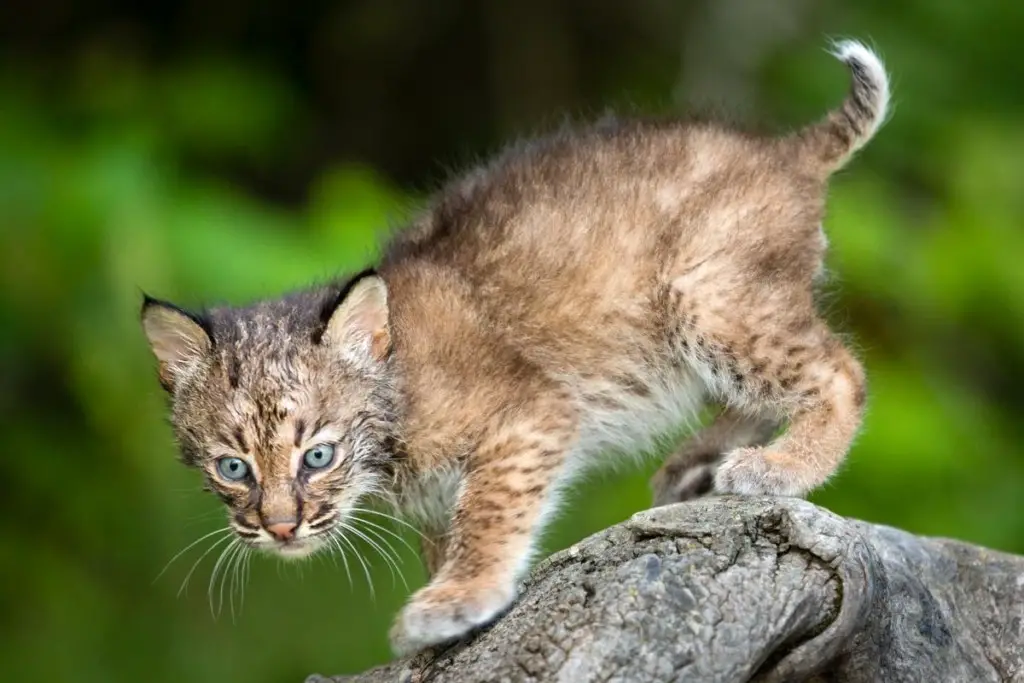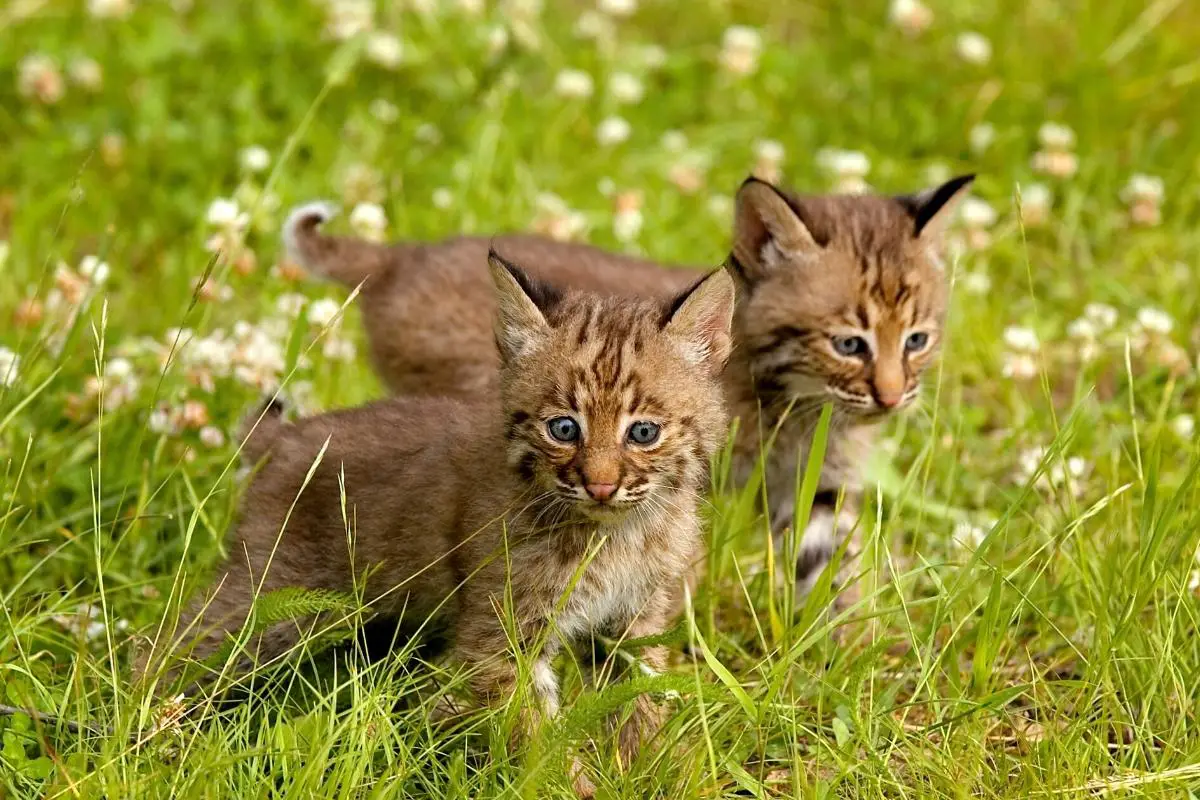Baby bobcats are rare to see. They are wild animals, and unless they are abandoned or rescued, a chance encounter with a litter of baby bobcats would be almost impossible.
That doesn’t mean that it couldn’t happen though, in fact, it does happen. Many people discover litters of bobcats, sometimes even mistaking them for housecat kittens. We’re going to answer all of your questions about bobcat babies, and what to do if you encounter them in the wild.
Scroll down for video and podcast versions of this story!
What are baby bobcats called?
Baby bobcats are called kittens. Female bobcats give birth around March through May, and have around 1-8 kittens per litter, with the average being around 3 kittens. Bobcat kittens are born blind and open their eyes around the 10th day. In rare cases, female bobcats can have two litters in a single year.
The mother raises the kittens alone, in a small den, usually a cave or under a tree stump or hollow tree. Sometimes a female from the previous litter will stick around to help raise the new litter. This happens with many animal species in the wild.
Want to listen to this article instead of reading it? Check out Episode 8 – Bobcat Babies on the Assorted Animals Podcast below!
Gestation and Early Life
The mating season for bobcats is around December and January. A bobcat’s gestation period is about 2 months long, so the babies are born sometime around February to May, or later. The litter size is around 1-6 kittens, however, they can have up to 8 kittens in a litter. 2-6 kittens are the average litter size.
When baby bobcats are born, they are raised inside of their small den. The mother bobcat raises the kittens alone. After mating, the male bobcats will go off and make their own dens, and then find another mate. Female bobcats will also mate with other males.
Kittens are preyed on by coyotes, wild dogs, and other large cats such as cougars. For this reason, the mothers are extremely territorial and protective. It has also been proven that more of the kittens in a litter will survive if the food source in their home range is abundant. Source.
How long do baby bobcats stay with their mother? Baby bobcats stay with their mother for around 1 year, dispersing in the coming spring. They are fully weaned around the 2-month mark. After this, they get familiar with the area around the den and outside of the den, and then they start to travel with their mother. In this period they learn skills that will keep them alive, such as hunting, foraging, and finding shelters/dens.
See our article for bobcat mating season click here.
What Do Baby Bobcats Look Like?
Baby bobcats look a lot like domestic kittens. At this stage, you really cannot tell a bobcat litter from a housecat litter, with an untrained eye. They are very small, much like regular kittens. Their tails are still too small for you to be able to see that they are short, after a few months, you will see that their tails will not grow longer.
The bobcat kittens can be born a yellow, grayish color, rusty color, and even a brown color, with dark-colored banding and spots on their ears and body. They will have banding and spots on their legs, body, and ears. They can sometimes be confused with tabby kittens and other types of housecat kittens.
Do Baby Bobcats Have Tails?
Baby bobcats have small tails, just like regular kittens. It takes a couple of months for their tails to get the full length. So you would have to wait sometime before you see that their tails are small/bobbed. If you saw a new litter of housecat kittens next to a new litter of bobcat kittens, you would not be able to tell them apart from tail length alone.
Bobcat kittens have spots or banding on the top side of their tails. The underneath of the baby bobcat’s tail is going to be a solid white/gray/yellow color. Their tail usually has a small bit of black fur on the tip. You can tell a baby bobcat, from a baby lynx, by the amount of black at the end of the tail. A bobcat kitten will have a small black tip, while a lynx will have a black tag on the end. As if it was dipped a few inches in black.
See our article for bobcat tails here.

Are Bobcat Babies Dangerous?
Bobcat babies are wild animals. Wild animals can be unpredictable at any size or age. You should be cautious about handling bobcat babies, and even more cautious about the mother being nearby, however, handling the kittens is not going to be life-threatening if the mother is gone.
As they get larger, the kittens can become more dangerous, with large claws on their paws, and sharp teeth. The paws of a bobcat are bigger than the paws on a housecat, and they can be much more dangerous.
Bobcats are wild, so their wild instincts can kick in, even when they are small kittens. This can result in scratches, cuts, bites, and more. If you find bobcat kittens, you should call in someone who has experience with wild animals, and bobcats specifically.
Bobcat Baby Sounds
Bobcat kittens are very vocal. Baby bobcats call out to their mother, for many different reasons. These calls can mean they are hungry, they are scared, and more. The mother will also cry out to her kittens, communicating with multiple calls.
They meow, they hoot, they purr, they screech, squeal, and more. Bobcat kittens make many noises, that they use to get their mother’s attention. The video below has many examples of bobcat baby sounds.
What to Do if You Find a Baby Bobcat
If you find what you believe to be a baby bobcat, you can use this article as a starting point for trying to identify the cat. When bobcats are kittens it can be very hard to tell the two apart.
However, your first action should be to observe them from a distance. If you think there is even the remote chance that they could be bobcat kittens, you need to get to a safe area, preferably in your vehicle.
If you do believe you have a bobcat kitten or even a litter of abandoned kittens on your hands, and there is no sign of a mother, then you should call in someone who has experience with handling wild animals, and if possible, bobcats specifically.
This may mean animal control, it could mean a veterinarian who has a history with bobcats, or an animal rescue that has a history with bobcats. Mother bobcats are extremely protective of their kittens. You need to keep your distance from the kittens until an expert arrives.
Do not try to transport the kittens yourself. This can be dangerous for many reasons. At this point, you need to let professionals do what they do best, rescue wild animals.
Can Baby Bobcats Be Pets?
There are rare instances where people have decided to raise bobcat kittens as pets. Raising exotic animals, and wild animals as pets is generally not a good idea. These animals need special care, a raw prey model diet, and enough room to run around, in an enclosed outdoor area.
These special needs can be very pricy. The amount of effort that goes into rescuing them and raising them is also very time-consuming. While it may be possible to form a bond with a bobcat kitten to tame them, they will never be domesticated. They are tamed wild animals that could lash out at any time.
See our article for bobcats as pets here.
How Can You Tell a Baby Bobcat From a Kitten?
You can tell a baby bobcat from a baby kitten by the spots on the kittens. If the kittens have spots, then there is a good chance they are going to be bobcat kittens. Most house cats do not have a large number of spots.
One problematic area, when identifying bobcat kittens, is that some domestic cats have their kittens in the wilderness or woods. Many feral cats also live in wooded areas. Because of this, people sometimes misidentify domestic cats for bobcats and vice versa. Just because you found the kittens in the woods, does not mean they are bobcats.
Genetically, you can tell the difference between bobcats and feral cats, with their skulls, because feral cats have an extra premolar in their top jaws. Source.
Frequently Asked Questions
Baby bobcats feed on their mother’s milk until they are weaned after 2 months. After that, the mother brings them meat to feed on. They become familiar with eating meat, and later they venture further to the opening of the den where the mother will leave live prey for them.
Bobcats sometimes have to abandon a baby that is too slow to keep up, this is a part of survival. A litter of bobcat kittens may become abandoned after their mother is killed, or the mother could also get separated because of bad weather and not find her way back to the kittens.
Baby bobcats are born sometime between February and May, although some litters can come later around June. Bobcat mothers can sometimes also have a second litter that is usually born around September and October.
Hybrids are thought to exist from bobcats mating with domestic cats. These hybrids are usually infertile. There are no known hybrid bloodlines of bobcats/domestic cats because their offspring cannot produce kittens.
- Hero Farm Dog Survives Epic Battle with Coyote Pack - December 9, 2024
- The 10-Minute Bedtime Routine That Changed My Dog’s Sleep Forever - November 29, 2024
- Creating a Safe Space for Nervous Pets: Your Guide to Pet-Friendly Havens - November 25, 2024

